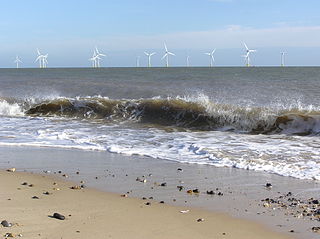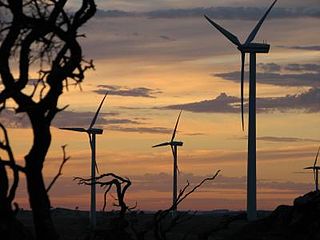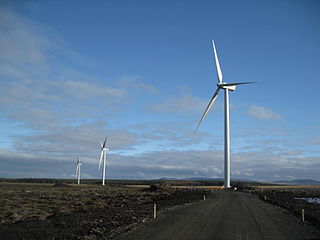
The Scroby Sands Wind Farm is a wind farm located on the Scroby Sands sandbank in the North Sea, 2.5 kilometres (1.6 mi) off the coast of Great Yarmouth in eastern England, United Kingdom. It was commissioned in March 2004 by Powergen Renewables Offshore, a division of E.ON UK. It has a nameplate capacity of 60 megawatts and is able to produce power to supply 41,000 households. Between 2005 and 2010, its capacity factor was between 26 and 32%. Its levelised cost has been estimated at £105/MWh.

The ExPlace Wind Turbine is a 91-metre (299 ft) tall wind turbine located on the grounds of the Exhibition Place co-owned by the WindShare for-profit co-operative and Toronto Hydro. It is the first wind turbine installed in a major North American urban city centre, and the first community-owned wind power project in Ontario. WindShare itself was officially launched in February 2002 in Toronto, Ontario, Canada. It was created by the non-profit Toronto Renewable Energy Co-operative (TREC) which was incorporated in 1998. TREC continues to exist as a separate non-profit entity.

The Blayney wind farm is a wind power station at Lake Carcoar, south of Blayney, New South Wales, Australia. It was acquired by Trustpower in 2014, and is now owned by Tilt Renewables. Blayney has fifteen wind turbines, with a total nameplate capacity of 9.9 MW of electricity.
The Thanet Wind Farm is an offshore wind farm 7 miles (11 km) off the coast of Thanet district in Kent, England. On commissioning it was the world's largest offshore wind farm. It has a nameplate capacity of 300 MW and it cost £780–900 million (US$1.2–1.4 billion). Thanet is one of fifteen Round 2 wind projects announced by the Crown Estate in January 2004 but the first to be developed. It was officially opened on 23 September 2010, when it overtook Horns Rev 2 as the biggest offshore wind farm in the world. It has since been overtaken by many others.

Canunda Wind Farm is a $92.5 million, 46 MW wind power project located on grazing land approximately 16 kilometres south of Millicent, and 6 kilometres west of Tantanoola in South Australia. It is jointly owned by GDF Suez Energy AustraliaEn 72%) and Mitsui (28%).

Burton Wold Wind Farm is a wind farm located near Burton Latimer in the English county of Northamptonshire, UK. The farm was developed by Your Energy Ltd, is owned by Mistral Windfarms and operated by Engineering Renewables Ltd. E.ON UK is buying the electricity output of the project under a long-term power purchase agreement. The farm is spread over three hectares. It has an installed capacity of 20 MW and generate on average around 40,000,000 units of electricity annually.

The Fântânele-Cogealac Wind Farm is the largest onshore wind farm in Romania and in Europe, with installed nameplate capacity of 600 MW from 240 General Electric 2.5xl wind turbines. The wind farm has been built for the ČEZ Group.

Community wind projects are locally owned by farmers, investors, businesses, schools, utilities, or other public or private entities who utilize wind energy to support and reduce energy costs to the local community. The key feature is that local community members have a significant, direct financial stake in the project beyond land lease payments and tax revenue. Projects may be used for on-site power or to generate wholesale power for sale, usually on a commercial-scale greater than 100 kW.

The Barrow Offshore Wind Farm is a 30 turbine 90MW capacity offshore wind farm in the East Irish Sea approximately 7 kilometres (4.3 mi) south west of Walney Island, near Barrow-in-Furness, Cumbria, England.

The Kentish Flats Offshore Wind Farm is a wind farm located off the coast of Kent, England on a large, flat and shallow plateau just outside the main Thames shipping lanes. The wind farm is operated by Vattenfall.
There are a number of wind power projects in the state of Maine, totaling more than 900 megawatts (MW) in capacity. In 2020 they were responsible for 24% of in-state electricity production. In 2019, Maine had more wind capacity than the other five New England states combined, at 923 MW.

Blyth Offshore Wind Farm was a small coastal wind farm located 0.5 miles (0.80 km) off the coast of Blyth, Northumberland, England.

Milton Keynes wind farm is located 2 miles east of Emberton in the City of Milton Keynes, Buckinghamshire, UK. It was developed by Your Energy and is owned by Mistral Windfarms. The wind farm comprises seven turbines 125 m to the blade tip, and has a total installed capacity of 14 MW. They were expected to produce approximately 38 GWh of electricity per year.

Pates Hill Wind Farm is located near the village of West Calder in West Lothian, Scotland. It consists of 7 Vestas V-80 wind turbines, measuring 107 metres to the blade tip. It became operational in February 2010 and is expected to generate electricity equivalent to the needs of approximately 8,000 households annually.

The Delabole wind farm was the first commercial onshore wind farm built in the United Kingdom, in November 1991. This field of wind turbines was initially developed by Windelectric Management Ltd.
REG WindPower is a renewable energy company, in the United Kingdom.
The Taralga Wind Farm is a wind farm located near Taralga, New South Wales.
The Rush Creek Wind Project is a 600 megawatt (MW) wind facility in eastern Colorado, located south of the town of Limon. It increased the wind generating capacity in the state by 20% when it came online in late 2018. The facility is financed, owned, and operated by Xcel Energy, the largest public utility in the state. The project was developed primarily for its numerous economic benefits since Xcel previously met the minimum 30% requirement of Colorado's 2020 renewable portfolio standard.
The Port Augusta Renewable Energy Park is a combined wind and solar farm under construction south of Port Augusta in South Australia, Australia. The solar farm is planned to be at the northern end of the site, west of the Augusta Highway and south of Sundrop Farms. The wind turbines will be on both sides of the Augusta Highway, extending south as far as the road to Horrocks Pass. Construction formally started in October 2020 and is estimated to take about 18 months to complete. The total site is about 5,400 hectares.
Taiba N'Diaye Wind Power Station,, is a 158.7 MW (212,800 hp) wind power plant in Senegal. The power station is the largest wind power station in West Africa, by generation capacity.















